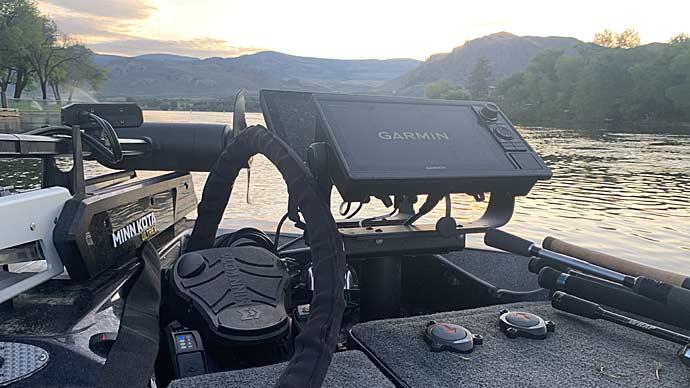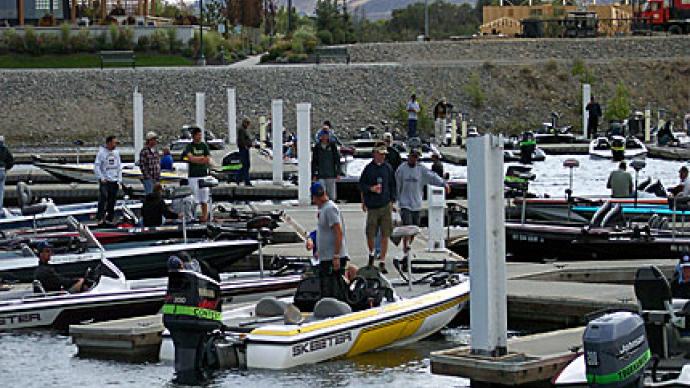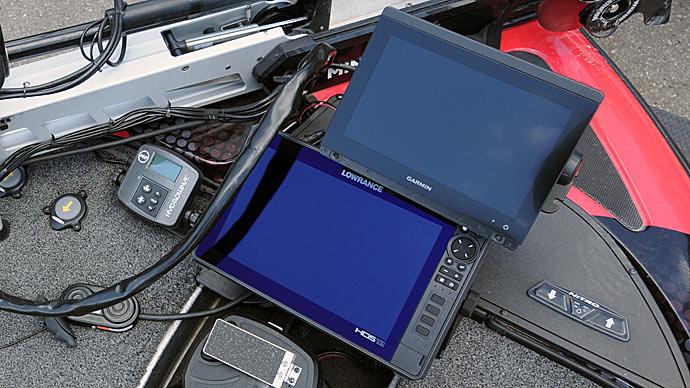One of the most confusing aspects of selecting a trolling motor is the array of electrical questions that inevitably arise. What type of trolling motor battery to buy? How many hours of trolling time does a specific motor offer? How are motors with multiple batteries wired? Given the importance of these issues, there is surprisingly little information regarding them online. This article covers the most common electrical issues and questions that arise when choosing and installing a trolling motor.
Battery Types
There are two types of twelve-volt batteries recommended for use with trolling motors; deep cycle marine batteries and AGM batteries.
Deep cycle marine batteries are specifically designed for the depletion and re-charging associated with trolling motor use, and are the most economical choice. They usually last from one to two and a half years years, are a standard lead-acid wet cell battery and can be purchased for less than $100.
The second option is an AGM battery, which stands for Absorbed Glass Mat. These batteries are built using a glass plate and a gel like substance vs. the standard lead-acid battery construction. AGM batteries last longer than standard deep cycle marine batteries, and also have a longer life span. While an average deep cycle marine battery may last less than two years, an AGM battery will usually last three to four. AGM batteries usually cost at least twice as much as a standard deep cycle marine battery, and may not be an option if the budget is tight. While a standard deep cell battery should provide adequate performance, AGM batteries are the best choice for longevity and performance over time.
Battery Life and Ratings
Batteries are rated using a metric called amperage hours. You can think of a battery's amperage hour rating like the gas tank in a car; the higher the rating, the larger the capacity and the longer the battery will be able to provide power. The amount of trolling time one can get out of a battery is dependent upon two factors: the number of amps drawn by your trolling motor and the amperage hour rating of your battery. For example, an 80 amperage hour battery means a battery would be able to supply 20 amps for 4 hours (20 * 4 = 80) or 40 amps for 2 hours (20 * 2 = 80) before running out of power.
It's easy to determine the amperage rating of your battery, but getting an idea for how many amps a given motor will use is a bit tricky. This information is often available in the literature and product manuals, but these aren't always easily accessible when shopping for a motor. While numbers vary by individual motor, the following chart offers an approximate idea of amperage drawn and battery life by motor size.
PLEASE NOTE: These are rough approximations based on certain Minn Kota motors but actual figures/results will vary, perhaps significantly, by specific model. While the figures listed below are believed to be fair approximations of expected performance they are only that - approximations. If you need exact run times for a specific motor, make sure to request the exact amperage drawn from the manufacturer.
Approximate Trolling Motor Battery Run Times
| Amps Dawn At Various Speeds | Approx. Run Time in Hrs | |||||
| Max Speed | Med Speed | Slow Speed | Max Speed | Med Speed | Slow Speed | |
| 30lbs | 30 | 15 | 5 | 3.3 | 6.7 | 20 |
| 40lbs - 70lbs | 40 | 20 | 5 | 2.5 | 5 | 20 |
| 80lbs - 100lbs | 50 | 25 | 5 | 2 | 4 | 20 |
As seen in the chart above, a fifty pound thrust motor operating at medium speed using a 100 amperage hour battery will get approximate 5 hours of run time. It's important to note that weather and water conditions can drastically affect battery performance. While a battery may draw 20 amps at medium speed in calm waters, it will draw significantly more at the same speed if it's fighting against the current or wind. If you regularly fish in bad weather or strong currents, you'll need to account for that in your battery life calculations and planning.
Extending Battery Life
There are a few things you can do to get the most out of your battery.
Use a Variable Speed Motor: Trolling motors come with either a variable speed or fixed speed motor. Variable speed motors let you set the motor speed exactly where you want it, where fixed speed motors usually have five pre-set speeds you have to choose from. Fixed speed motors are usually about $100 cheaper than similar variable speed motors, but are less efficient with regards to battery consumption. If your ideal speed is twenty-five percent of full power, a variable speed motor lets you dial-in exactly the speed you need, and you use only the power needed for that speed. With a fixed speed motor, the speed setting you want may be between pre-set speeds. To achieve the speed you want, you have to go faster than you really need and, subsequently, use more power than you otherwise would with a variable speed motor. Apart from battery efficiency benefits, variable speed motors are simply more convenient and are often worth the additional price.
Battery Enhancing Technologies: Certain motors come with technology specifically designed to squeeze the most trolling time possible out of a single charge. Once such technology is Digital Maximizer from Minn Kota, which claims to extend battery run time up to five times that of a standard motor in certain situations. Whether or not the technology delivers a full five hundred percent improvement in battery life, technologies such as these are a great way to get more run time out of your battery.
Don't Fully Deplete Your Battery: While deep cycle marine batteries are designed to be charged and depleted frequently, it's never good for your battery to be run completely down. Doing this regularly will almost certainly shorten your battery life. While you can deplete the battery to near empty, it's best to recharge before running it down to absolutely no power. Using a trolling motor with a built-in battery meter, or purchasing an external one is a great way to keep tabs on how much power you have left. It will also reduce the chances of running out of trolling power miles from shore!
Remember Batteries in the Off-Season: When batteries aren't used or charged for extended periods, their life can be significantly decreased. Letting a battery set unused in the fishing off-season from September through May will likely reduce the number of charges you'll get out of it.
There are two ways to keep your batteries healthy throughout the off-season. Those serious about battery maintenance can purchase a battery tender, a device that continually puts a very small charge into a battery. This keeps the battery healthy and charged over time without having a regular, full power charger always connected. The second way is to re-charge your battery approximately every four weeks. Battery experts say that deep cycle marine batteries should go no more than four weeks without being charged. If not using a battery tender, charging your battery once a month in the winter can significantly increase its life.
Twelve-volt, Twenty-four volt and Thirty-six volt motors
Most high-powered trolling motors in the seventy to one hundred pound thrust range are twenty-four volt or thirty-six volt motors, and require two or three batteries to operate. The addition of extra batteries usually introduces confusion regarding proper wiring, battery life and other issues, so it's important to understand the implications of multiple battery systems.
Twenty-four volt and thirty-six volt trolling motors need to have their batteries wired in series, which simply means the two batteries need to be connected to each other, and the trolling motor leads attached to the other remaining battery terminals. Wiring a thirty-six volt trolling motor, which uses three batteries, looks very similar and follows the same process. In the picture above, a wire would be run from negative terminal of the second battery (on the right) to the positive terminal of the third battery. Another lead would be run from the negative lead of the third battery to the circuit breaker, completing the circuit back to the motor. Nearly all twenty-four volt and thirty-six volt motors will include the wiring needed to connect the batteries in series.
You may have heard that twenty-four volt and thirty-six volt motors offer better battery life compared to single twelve-volt motors, a statement which can be a bit misleading. Take the following example assuming 100 amperage hour rated batteries: if a twelve-volt motor and a twenty-four volt motor both draw 15 amps, it would seem logical that the twenty-four volt system with two batteries would have twice the battery life, but this is NOT true! Even with two batteries rated at 100 amperage hours, the total number of amperage hours available is still 100 - the same as the twelve-volt single battery motor. Stated differently, you can't add the amperage hours from multiple batteries together for additional run time. The second battery is needed to provide more voltage and power for the larger motor, but doesn't extend the run time. To use the gas tank analogy, the second battery doesn't give you extra gas in the tank; it just provides more power much like using diesel instead of regular gas.
While a bit misleading, there is some truth in the efficiency claims of larger motors. If you put a twenty-four volt or thirty-six volt motor on a boat that only needs a twelve-volt motor, you can operate your trolling motor much longer! This is because a twenty-four volt or thirty-six volt motor can generate the same thrust at a lower amperage draw than a standard twelve-volt motor, resulting in a battery that isn't depleted as quickly. If battery life is important to you and you don't need more than say, sixty pounds of thrust, you may want to consider jumping up to a seventy-pound or greater twenty-four volt or thirty-six volt motor simply for the "improved" battery life it offers. You many never need all the upper end power offered, but you'll be able to spend more time on the water trolling at slower speeds compared to a standard twelve-volt motor.
Battery Chargers
After returning from a longer day on the water, you'll want to recharge your batteries so they're ready for the next outing. When it comes to chargers, there are three basic types you can pick from.
Portable AC Chargers: Portable chargers are very similar to most twelve-volt battery chargers you've seen. They are easily transportable, plug into an AC outlet and charge a battery with alligator clips. If you have a smaller boat and don't have room to permanently install a charger onboard, a portable charger is your best bet.
On-Board AC Chargers: Onboard AC chargers are designed to be permanently installed in your boat. They are wired to your batteries so that when arriving home, you can simply plug the charger into a standard AC outlet to recharge your batteries. Onboard chargers are fast, convenient and are the most popular type of charger used. Onboard chargers come pre-installed on certain boats.
On-Board DC Chargers: On-Board DC chargers are also permanently installed, but are powered by the boat's alternator on the gasoline engine. Trolling motor batteries can be recharged out on the water away from an AC outlet, but the gasoline motor must be running in order to charge the batteries. Depending on your charger and the size of your batteries, it may require hours of engine run time to achieve a full charge. If you take extended, possibly multi-day trips with your boat a DC charger may be just what you need. Otherwise, an on-board AC charger will likely be more convenient for achieving consistent, full charges.
You'll need to pick an AC charger with the proper number of banks and select an amperage rating. The number of "banks" a charger has refers to how many batteries a charger can charge simultaneously. A single bank charger can only charge a single twelve-volt battery, while a triple bank charger can charge three batteries at the same time. You'll almost certainly want a single bank charger for a twelve-volt system, a dual bank charger for a twenty-four volt system, and a triple bank charger for a thirty-six volt system. While you could conceivably charge two or three batteries separately with a single bank charger, it's much more convenient to have all your batteries charged in one session.
A charger's amperage rating indicates how fast it can charge a twelve-volt battery. The higher the amperage rating, the faster it will charge the battery to full capacity. Listed below is a rough estimation of how long various amperage rating chargers will take to fully charge a near empty twelve-volt battery.
Five Amp Charger - Eight to ten hours
Ten Amp Charger - Six to eight hours
Fifteen Amp Charger - Four to six hours
If you spend a lot of time fishing back-to-back days with late evenings and early mornings, you'll likely want to invest in a ten or fifteen amp charger to ensure your batteries are recharged as quickly as possible. If your trips are more infrequent, the eight to ten hour recharge time offered by a five-amp charger should work just fine.
Miscellaneous Wiring Issues
There are a few remaining wiring and electrical issues that should be noted.
Circuit Breakers: You'll only burn up one expensive trolling motor before investing in a circuit breaker! A circuit breaker protects your motor in the event the prop gets caught in heavy weeds, jammed, or stuck on a rock. Without a breaker, the motor would draw more and more power in an attempt to try to turn the jammed prop until it eventually burns itself up, causing irreversible damage. If installed, a circuit breaker will break the circuit in the event a certain amperage level is reached, cutting power to the motor and preventing a burnout. You'll want to make sure your circuit breaker is rated just above the maximum amperage drawn by your motor at max speed. For most motors, a sixty-amp circuit breaker should offer upside protection without tripping at normal operating speeds.
Wire Extensions: In the event you need to run wire extensions for your motor and battery wiring, you'll want to use six-gauge wire if the extension is more than six feet. If the extension is shorter than six feet, you can use eight-gauge wire without a problem.




